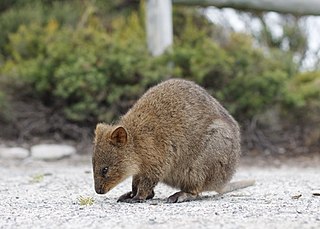
The quokka is a small macropod about the size of a domestic cat. It is the only member of the genus Setonix. Like other marsupials in the macropod family, the quokka is herbivorous and mainly nocturnal.

Nemesiidae, also known as funnel-web trapdoor spiders, is a family of mygalomorph spiders first described by Eugène Simon in 1889, and raised to family status in 1985. Before becoming its own family, it was considered part of "Dipluridae".

Idiosoma is a genus of Australian armoured trapdoor spiders that was first described by Anton Ausserer in 1871. Originally placed with the Ctenizidae, it was moved to the armoured trapdoor spiders in 1985. The name is derived from the Greek ἴδιος, meaning "individual, unique", and σῶμα, meaning "body", referring to the distinctive structure of the abdomen.
Granite outcrops of Western Australia are weathered landforms that occur throughout the state of Western Australia, composed primarily of the rock type granite. All recognised types of this landform can be observed, commonly as bornhardts, but also as inselbergs, castle koppies and nubbins. Rising abruptly from the surrounding landscape they create a variety of microhabitats for plants, and provide seasonal resources and refuge for a range of animals. These areas thus have rich biodiversity and many endemic species. They are significant locations that tie in with the Aboriginal and European cultural heritage of Western Australia.
Teyl is a genus of spiders in the family Anamidae. It is endemic to Australia. It is one of the genera that was placed in the former tribe Teylini. The type species is T. luculentus.

Mallee, also known as Roe Botanical District, is a biogeographic region in southern Western Australia. Located between the Esperance Plains, Avon Wheatbelt and Coolgardie bioregions, it has a low, gently undulating topography, a semi-arid mediterranean climate, and extensive Eucalyptus mallee vegetation. It has an area of 73,975.59 square kilometres (28,562.13 sq mi). About half of the region has been cleared for intensive agriculture. Recognised as a region under the Interim Biogeographic Regionalisation for Australia (IBRA), it was first defined by John Stanley Beard in 1980.

Camaenidae is a family of air-breathing land snails, terrestrial pulmonate gastropod mollusks in the superfamily Helicoidea, the typical snails and their allies. This is one of the most diverse families in the clade Stylommatophora.
Rhytidosteoidea is a superfamily of Temnospondyli, early amphibian species that existed during the Carboniferous, Permian, and Triassic periods. The taxon was established in 1965 to accommodate two new species of Deltasaurus, the author recognising an alliance with previously described genera.
Cataxia is a genus of Australian armoured trapdoor spiders that was first described by William Joseph Rainbow in 1914.
Euoplos is a genus of Australian armoured trapdoor spiders that was first described by William Joseph Rainbow in 1914.
Ferries McDonald Conservation Park is a protected area in the Australian state of South Australia located in the gazetted locality of Monarto South about 10 kilometres (6.2 mi) south-west of Murray Bridge. It covers an area of 845 hectares and provides a habitat for a range of native and endangered species. It is one of a number of protected patches of remnant mallee bushland within the region. Conservation organisations are now attempting to restore and connect these patches of the fragmented Murray plains in an attempt to heighten the prospects of various rare and endangered species.
Pseudoteyl is a genus of spiders in the family Nemesiidae. It was first described in 1985 by Main. As of 2017, it contains only one species, Pseudoteyl vancouveri, found in Australia.

Anamidae is a family of Australian mygalomorph spiders. It was first described as a tribe by Simon in 1889, then raised to the subfamily Anaminae of the family Nemesiidae, before being raised to a family level by Opatova et al. in 2020.
Teyl harveyi is a species of mygalomorph spider in the Anamidae family. It is endemic to Australia. It was described in 2004 by Australian arachnologist Barbara York Main.
Teyl walkeri is a species of mygalomorph spider in the Anamidae family. It is endemic to Australia. It was described in 2004 by Australian arachnologist Barbara York Main.
Teyl yeni is a species of mygalomorph spider in the Anamidae family. It is endemic to Australia. It was described in 2004 by Australian arachnologist Barbara York Main.
Teyl luculentus, also known as the citrine spider, is a species of mygalomorph spider in the Anamidae family. It is endemic to Australia. It was described in 1975 by Australian arachnologist Barbara York Main, and is the type species of the genus.
Teyl damsonoides is a species of mygalomorph spider in the Anamidae family. It is endemic to Australia. It was described in 1983 by Australian arachnologist Barbara York Main.
Teyl heuretes is a species of mygalomorph spider in the Anamidae family. It is endemic to Australia. It was described in 2019 by Joel Huey, Michael Rix, Jeremy Wilson, Mia Hillyer and Mark Harvey.





